Hmong vs Korean Community Comparison
COMPARE
Hmong
Korean
Social Comparison
Social Comparison
Hmong
Koreans
4,737
SOCIAL INDEX
44.9/ 100
SOCIAL RATING
196th/ 347
SOCIAL RANK
6,713
SOCIAL INDEX
64.6/ 100
SOCIAL RATING
147th/ 347
SOCIAL RANK
Korean Integration in Hmong Communities
The statistical analysis conducted on geographies consisting of 24,553,297 people shows a mild negative correlation between the proportion of Koreans within Hmong communities in the United States with a correlation coefficient (R) of -0.334. On average, for every 1% (one percent) increase in Hmong within a typical geography, there is a decrease of 1.406% in Koreans. To illustrate, in a geography comprising of 100,000 individuals, a rise of 1,000 Hmong corresponds to a decrease of 1,405.7 Koreans.
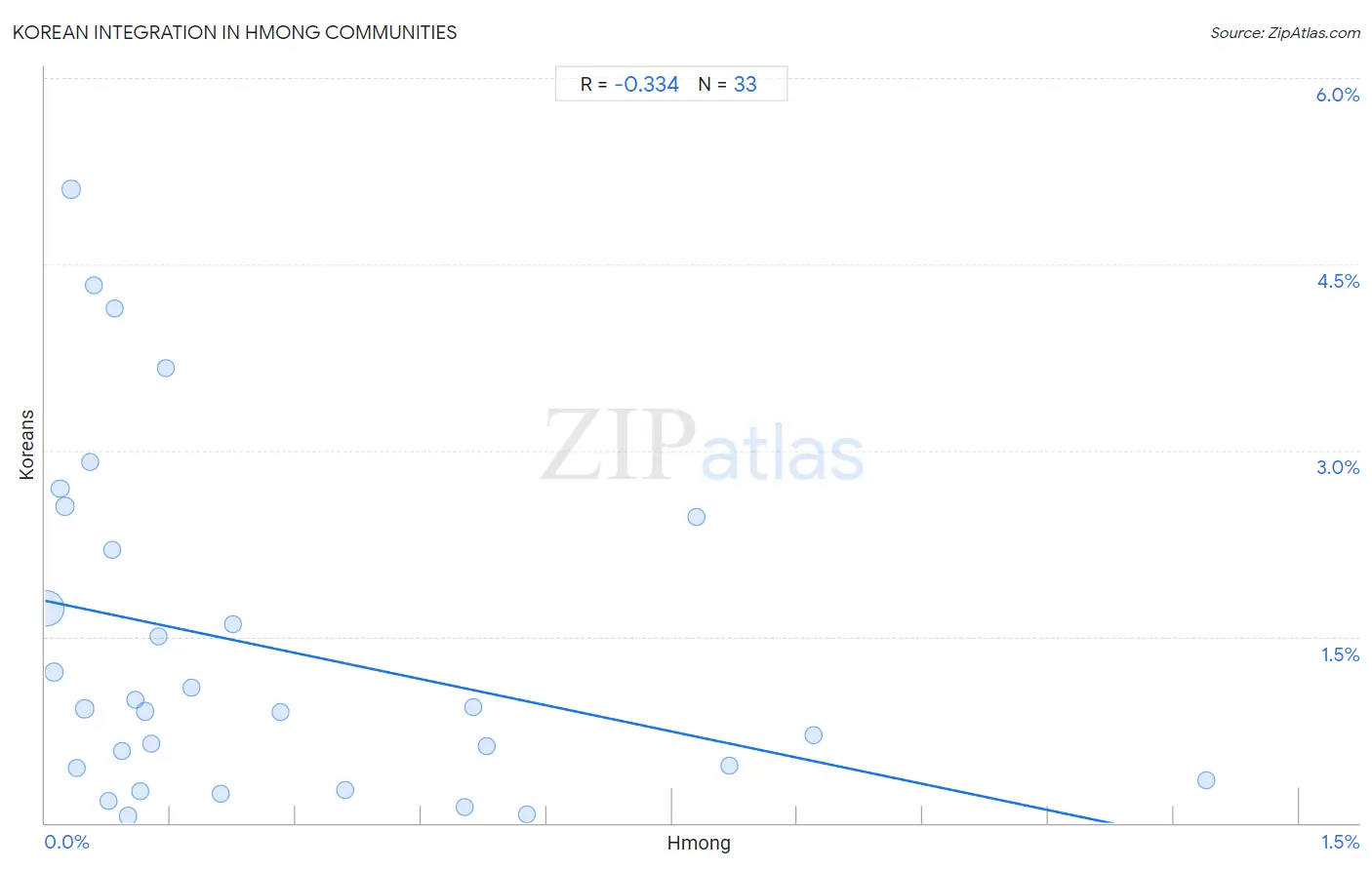
Hmong vs Korean Income
When considering income, the most significant differences between Hmong and Korean communities in the United States are seen in median household income ($75,839 compared to $95,018, a difference of 25.3%), householder income ages 45 - 64 years ($88,115 compared to $110,334, a difference of 25.2%), and householder income ages 25 - 44 years ($84,258 compared to $103,824, a difference of 23.2%). Conversely, both communities are more comparable in terms of wage/income gap (27.7% compared to 25.4%, a difference of 8.8%), median earnings ($42,111 compared to $48,727, a difference of 15.7%), and median female earnings ($35,498 compared to $41,276, a difference of 16.3%).

| Income Metric | Hmong | Korean |
| Per Capita Income | Tragic $38,120 | Good $44,522 |
| Median Family Income | Tragic $91,296 | Exceptional $110,103 |
| Median Household Income | Tragic $75,839 | Exceptional $95,018 |
| Median Earnings | Tragic $42,111 | Exceptional $48,727 |
| Median Male Earnings | Tragic $48,254 | Excellent $56,672 |
| Median Female Earnings | Tragic $35,498 | Exceptional $41,276 |
| Householder Age | Under 25 years | Tragic $49,364 | Exceptional $57,730 |
| Householder Age | 25 - 44 years | Tragic $84,258 | Exceptional $103,824 |
| Householder Age | 45 - 64 years | Tragic $88,115 | Exceptional $110,334 |
| Householder Age | Over 65 years | Tragic $56,339 | Exceptional $67,472 |
| Wage/Income Gap | Tragic 27.7% | Good 25.4% |
Hmong vs Korean Poverty
When considering poverty, the most significant differences between Hmong and Korean communities in the United States are seen in single male poverty (14.2% compared to 11.0%, a difference of 29.2%), child poverty under the age of 5 (18.5% compared to 14.4%, a difference of 28.8%), and child poverty among girls under 16 (17.5% compared to 14.1%, a difference of 24.4%). Conversely, both communities are more comparable in terms of seniors poverty over the age of 65 (10.4% compared to 10.1%, a difference of 3.4%), seniors poverty over the age of 75 (12.0% compared to 11.5%, a difference of 4.2%), and receiving food stamps (10.9% compared to 10.4%, a difference of 4.8%).
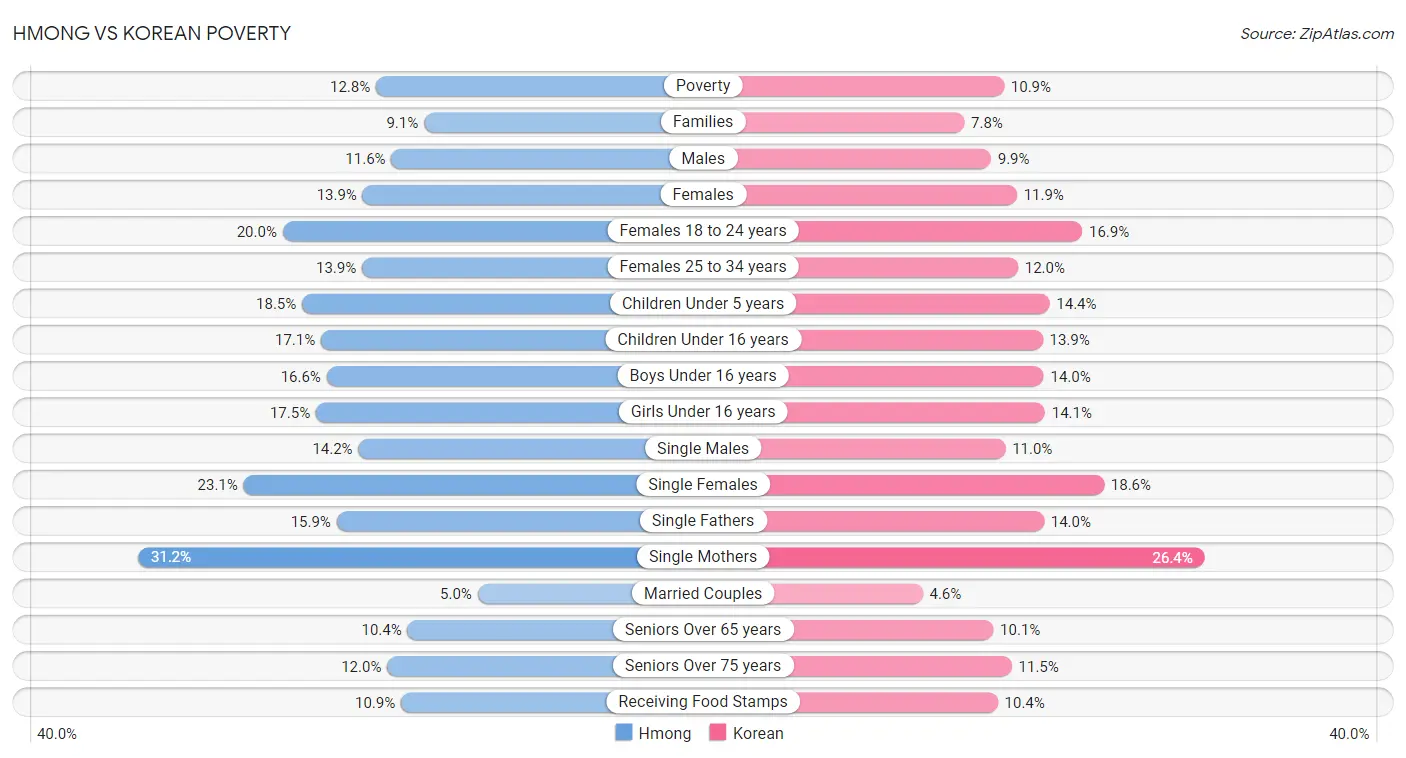
| Poverty Metric | Hmong | Korean |
| Poverty | Poor 12.8% | Exceptional 10.9% |
| Families | Average 9.1% | Exceptional 7.8% |
| Males | Poor 11.6% | Exceptional 9.9% |
| Females | Fair 13.9% | Exceptional 11.9% |
| Females 18 to 24 years | Average 20.0% | Exceptional 16.9% |
| Females 25 to 34 years | Fair 13.9% | Exceptional 12.0% |
| Children Under 5 years | Tragic 18.5% | Exceptional 14.4% |
| Children Under 16 years | Poor 17.1% | Exceptional 13.9% |
| Boys Under 16 years | Fair 16.6% | Exceptional 14.0% |
| Girls Under 16 years | Poor 17.5% | Exceptional 14.1% |
| Single Males | Tragic 14.2% | Exceptional 11.0% |
| Single Females | Tragic 23.1% | Exceptional 18.6% |
| Single Fathers | Exceptional 15.9% | Exceptional 14.0% |
| Single Mothers | Tragic 31.2% | Exceptional 26.4% |
| Married Couples | Excellent 5.0% | Exceptional 4.6% |
| Seniors Over 65 years | Exceptional 10.4% | Exceptional 10.1% |
| Seniors Over 75 years | Good 12.0% | Exceptional 11.5% |
| Receiving Food Stamps | Excellent 10.9% | Exceptional 10.4% |
Hmong vs Korean Unemployment
When considering unemployment, the most significant differences between Hmong and Korean communities in the United States are seen in unemployment among seniors over 75 years (13.7% compared to 8.9%, a difference of 54.4%), unemployment among ages 65 to 74 years (4.2% compared to 5.3%, a difference of 25.8%), and unemployment among ages 60 to 64 years (4.0% compared to 4.9%, a difference of 23.1%). Conversely, both communities are more comparable in terms of male unemployment (5.5% compared to 5.3%, a difference of 2.9%), unemployment among ages 35 to 44 years (5.0% compared to 4.8%, a difference of 4.1%), and unemployment among women with children ages 6 to 17 years (8.7% compared to 8.2%, a difference of 5.9%).
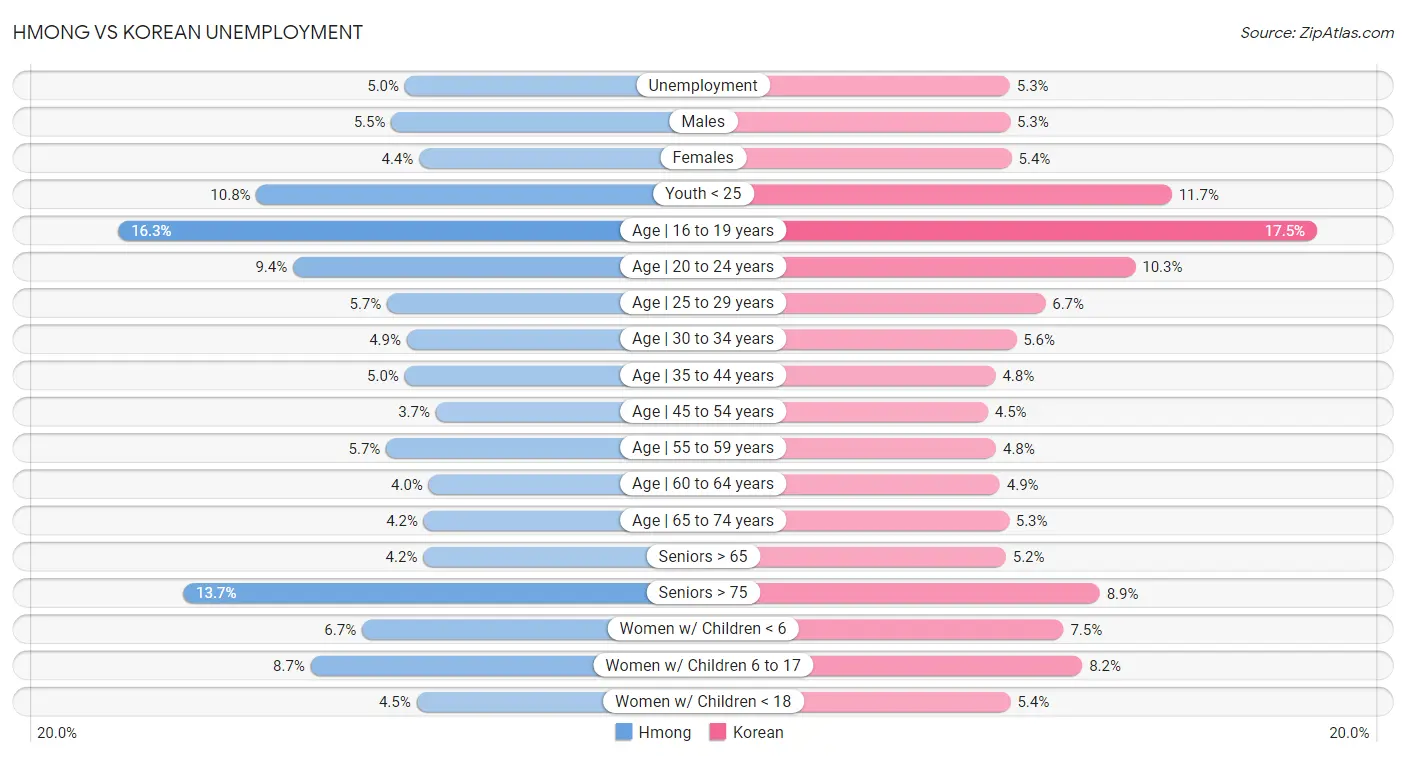
| Unemployment Metric | Hmong | Korean |
| Unemployment | Exceptional 5.0% | Fair 5.3% |
| Males | Tragic 5.5% | Fair 5.3% |
| Females | Exceptional 4.4% | Poor 5.4% |
| Youth < 25 | Exceptional 10.8% | Fair 11.7% |
| Age | 16 to 19 years | Exceptional 16.3% | Good 17.5% |
| Age | 20 to 24 years | Exceptional 9.4% | Average 10.3% |
| Age | 25 to 29 years | Exceptional 5.7% | Fair 6.7% |
| Age | 30 to 34 years | Exceptional 4.9% | Fair 5.6% |
| Age | 35 to 44 years | Tragic 5.0% | Fair 4.8% |
| Age | 45 to 54 years | Exceptional 3.7% | Good 4.5% |
| Age | 55 to 59 years | Tragic 5.7% | Good 4.8% |
| Age | 60 to 64 years | Exceptional 4.0% | Poor 4.9% |
| Age | 65 to 74 years | Exceptional 4.2% | Excellent 5.3% |
| Seniors > 65 | Exceptional 4.2% | Fair 5.2% |
| Seniors > 75 | Tragic 13.7% | Fair 8.9% |
| Women w/ Children < 6 | Exceptional 6.7% | Excellent 7.5% |
| Women w/ Children 6 to 17 | Exceptional 8.7% | Exceptional 8.2% |
| Women w/ Children < 18 | Exceptional 4.5% | Good 5.4% |
Hmong vs Korean Labor Participation
When considering labor participation, the most significant differences between Hmong and Korean communities in the United States are seen in in labor force | age 16-19 (38.7% compared to 35.7%, a difference of 8.4%), in labor force | age 30-34 (82.4% compared to 84.5%, a difference of 2.5%), and in labor force | age > 16 (64.1% compared to 65.7%, a difference of 2.5%). Conversely, both communities are more comparable in terms of in labor force | age 25-29 (83.7% compared to 84.2%, a difference of 0.60%), in labor force | age 20-24 (76.5% compared to 75.4%, a difference of 1.5%), and in labor force | age 45-54 (81.7% compared to 82.9%, a difference of 1.5%).

| Labor Participation Metric | Hmong | Korean |
| In Labor Force | Age > 16 | Tragic 64.1% | Exceptional 65.7% |
| In Labor Force | Age 20-64 | Tragic 77.9% | Good 79.8% |
| In Labor Force | Age 16-19 | Exceptional 38.7% | Poor 35.7% |
| In Labor Force | Age 20-24 | Exceptional 76.5% | Good 75.4% |
| In Labor Force | Age 25-29 | Tragic 83.7% | Tragic 84.2% |
| In Labor Force | Age 30-34 | Tragic 82.4% | Fair 84.5% |
| In Labor Force | Age 35-44 | Tragic 82.6% | Fair 84.3% |
| In Labor Force | Age 45-54 | Tragic 81.7% | Good 82.9% |
Hmong vs Korean Family Structure
When considering family structure, the most significant differences between Hmong and Korean communities in the United States are seen in births to unmarried women (27.7% compared to 30.1%, a difference of 8.6%), divorced or separated (12.3% compared to 11.3%, a difference of 8.4%), and single mother households (6.4% compared to 6.0%, a difference of 6.0%). Conversely, both communities are more comparable in terms of single father households (2.4% compared to 2.4%, a difference of 0.79%), currently married (47.1% compared to 47.9%, a difference of 1.8%), and family households with children (28.6% compared to 29.2%, a difference of 2.1%).

| Family Structure Metric | Hmong | Korean |
| Family Households | Exceptional 64.9% | Exceptional 68.3% |
| Family Households with Children | Exceptional 28.6% | Exceptional 29.2% |
| Married-couple Households | Good 47.0% | Exceptional 49.7% |
| Average Family Size | Fair 3.21 | Exceptional 3.36 |
| Single Father Households | Fair 2.4% | Fair 2.4% |
| Single Mother Households | Fair 6.4% | Excellent 6.0% |
| Currently Married | Good 47.1% | Exceptional 47.9% |
| Divorced or Separated | Tragic 12.3% | Exceptional 11.3% |
| Births to Unmarried Women | Exceptional 27.7% | Excellent 30.1% |
Hmong vs Korean Vehicle Availability
When considering vehicle availability, the most significant differences between Hmong and Korean communities in the United States are seen in no vehicles in household (10.4% compared to 8.0%, a difference of 29.7%), 4 or more vehicles in household (7.0% compared to 8.6%, a difference of 23.9%), and 3 or more vehicles in household (21.0% compared to 24.1%, a difference of 14.7%). Conversely, both communities are more comparable in terms of 1 or more vehicles in household (89.6% compared to 92.1%, a difference of 2.7%), 2 or more vehicles in household (57.8% compared to 61.0%, a difference of 5.5%), and 3 or more vehicles in household (21.0% compared to 24.1%, a difference of 14.7%).

| Vehicle Availability Metric | Hmong | Korean |
| No Vehicles Available | Average 10.4% | Exceptional 8.0% |
| 1+ Vehicles Available | Average 89.6% | Exceptional 92.1% |
| 2+ Vehicles Available | Exceptional 57.8% | Exceptional 61.0% |
| 3+ Vehicles Available | Exceptional 21.0% | Exceptional 24.1% |
| 4+ Vehicles Available | Exceptional 7.0% | Exceptional 8.6% |
Hmong vs Korean Education Level
When considering education level, the most significant differences between Hmong and Korean communities in the United States are seen in no schooling completed (1.9% compared to 2.4%, a difference of 22.1%), doctorate degree (1.6% compared to 1.7%, a difference of 9.4%), and professional degree (3.7% compared to 4.1%, a difference of 8.6%). Conversely, both communities are more comparable in terms of nursery school (98.1% compared to 97.7%, a difference of 0.40%), kindergarten (98.1% compared to 97.6%, a difference of 0.42%), and 1st grade (98.0% compared to 97.6%, a difference of 0.43%).
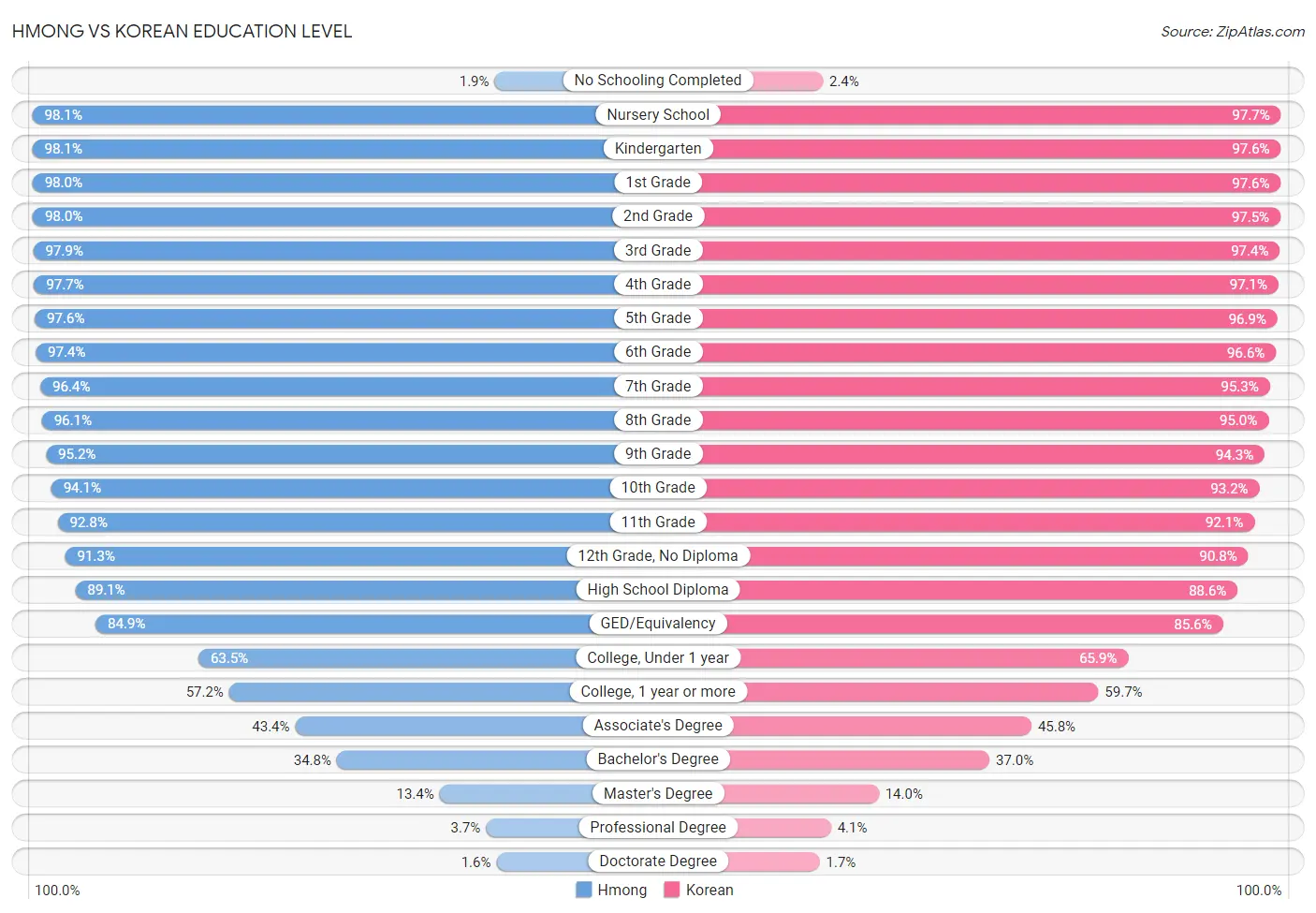
| Education Level Metric | Hmong | Korean |
| No Schooling Completed | Excellent 1.9% | Tragic 2.4% |
| Nursery School | Good 98.1% | Tragic 97.7% |
| Kindergarten | Good 98.1% | Tragic 97.6% |
| 1st Grade | Good 98.0% | Tragic 97.6% |
| 2nd Grade | Good 98.0% | Tragic 97.5% |
| 3rd Grade | Excellent 97.9% | Tragic 97.4% |
| 4th Grade | Excellent 97.7% | Tragic 97.1% |
| 5th Grade | Exceptional 97.6% | Tragic 96.9% |
| 6th Grade | Exceptional 97.4% | Tragic 96.6% |
| 7th Grade | Exceptional 96.4% | Tragic 95.3% |
| 8th Grade | Excellent 96.1% | Tragic 95.0% |
| 9th Grade | Excellent 95.2% | Tragic 94.3% |
| 10th Grade | Excellent 94.1% | Tragic 93.2% |
| 11th Grade | Good 92.8% | Poor 92.1% |
| 12th Grade, No Diploma | Average 91.3% | Fair 90.8% |
| High School Diploma | Average 89.1% | Poor 88.6% |
| GED/Equivalency | Poor 84.9% | Average 85.6% |
| College, Under 1 year | Tragic 63.5% | Good 65.9% |
| College, 1 year or more | Tragic 57.2% | Average 59.7% |
| Associate's Degree | Tragic 43.4% | Fair 45.8% |
| Bachelor's Degree | Tragic 34.8% | Fair 37.0% |
| Master's Degree | Tragic 13.4% | Poor 14.0% |
| Professional Degree | Tragic 3.7% | Poor 4.1% |
| Doctorate Degree | Tragic 1.6% | Poor 1.7% |
Hmong vs Korean Disability
When considering disability, the most significant differences between Hmong and Korean communities in the United States are seen in disability age 18 to 34 (8.1% compared to 6.3%, a difference of 28.2%), disability age 35 to 64 (13.1% compared to 10.5%, a difference of 25.5%), and disability age 5 to 17 (6.3% compared to 5.1%, a difference of 25.2%). Conversely, both communities are more comparable in terms of disability age over 75 (48.2% compared to 48.6%, a difference of 0.87%), self-care disability (2.4% compared to 2.5%, a difference of 4.8%), and disability age under 5 (1.1% compared to 1.2%, a difference of 4.8%).
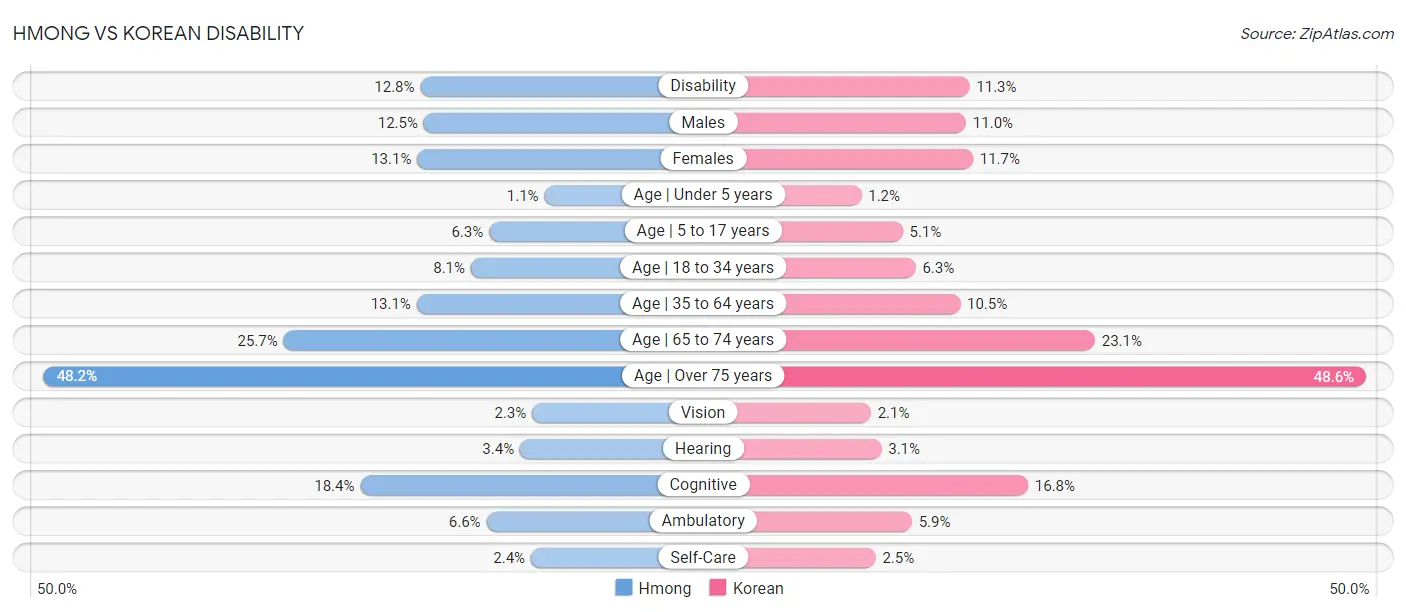
| Disability Metric | Hmong | Korean |
| Disability | Tragic 12.8% | Exceptional 11.3% |
| Males | Tragic 12.5% | Good 11.0% |
| Females | Tragic 13.1% | Exceptional 11.7% |
| Age | Under 5 years | Exceptional 1.1% | Excellent 1.2% |
| Age | 5 to 17 years | Tragic 6.3% | Exceptional 5.1% |
| Age | 18 to 34 years | Tragic 8.1% | Exceptional 6.3% |
| Age | 35 to 64 years | Tragic 13.1% | Exceptional 10.5% |
| Age | 65 to 74 years | Tragic 25.7% | Good 23.1% |
| Age | Over 75 years | Tragic 48.2% | Tragic 48.6% |
| Vision | Tragic 2.3% | Exceptional 2.1% |
| Hearing | Tragic 3.4% | Fair 3.1% |
| Cognitive | Tragic 18.4% | Exceptional 16.8% |
| Ambulatory | Tragic 6.6% | Exceptional 5.9% |
| Self-Care | Excellent 2.4% | Poor 2.5% |